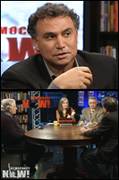
Guests
- Faraz SaneiA researcher in the Middle East and North Africa division for Human Rights Watch.
In Iran, tens of thousands of people took to the streets Monday in the largest Iranian protests since the aftermath of the nation’s disputed 2009 election. At least one protester died and several were injured as security forces used tear gas, pepper spray and batons in an attempt to disperse the crowds. Dozens of protesters were detained.
Iranian lawmakers denounced Monday’s protests and are calling for the execution of two opposition leaders and former presidential candidates, Mehdi Karroubi and Mir Hossein Mousavi, for inciting the February 14 demonstrations.
Faraz Sanei, researcher for Human Rights Watch, recounts the day’s events for Democracy Now!
FARAZ SANEI: Today the people of Iran heeded the call of Mir Hossein Mousavi and Mehdi Karroubi, who are two opposition leaders in Iran, who had actually, on February the 5th, summoned the people of Iran to come out into the streets and demonstrate peacefully in support of the popular movements in Egypt and in Tunisia. They had actually written a letter, a public letter, to the Ministry of Interior asking for a permit for the public demonstrations on February the 14th, which was today, and the Ministry of Interior neglected to actually respond to or issue a permit, which is something that they have not actually done for any of the protests in the past year, year and a half or so since the disputed June 2009 elections. But regardless, the people came out, listened to the calls of Mousavi and Karroubi, and went out into the streets.
We don’t really have exact numbers on the numbers of individuals who participated in the demonstrations today, but we do know that thousands of individuals in Tehran, in Shiraz, in Isfahan, in Kermanshah, in Rasht — these are some of the larger cities in Iran — did actually participate in the protests.
And the protests in Tehran started at around 3:00, 3:00 p.m. in the afternoon. There were designated routes that had been predetermined prior to the demonstrations. And, of course, there was a very, very heavy security presence in the streets in Tehran and in other cities, as well, the security forces including the regular police units, the riot police and plainclothes militia, which usually work with the Basij, which is the Islamic militia that is — that was so prevalent in the 2009 elections in the aftermath, in terms of cracking down on protesters. They basically had positioned themselves and were ready for protesters.
And as protesters started to walk into the streets, in the beginning there weren’t that many clashes, but after a while, clashes began. Often the protesters would yell, they would chant slogans, and in response, the security forces would actually try to disperse them. They would go after them. There were lots of reports of violence in various parts of the the city, in Tehran and in other cities. The riot police, in particular, and the Basij, plainclothes militia, were responsible for going after individuals with batons, with tear gas and with sticks. And as far as we know, most of the demonstrations were peaceful. It’s just that the security forces were trying to disperse the crowds and not allow them to actually go to their final destinations in the various cities.
And the latest reports that we have are that one person was actually killed. It is not clear exactly who that person is. Their identity has not been divulged yet. But pro-government media, Fars News Agency, actually did claim that an individual had been killed. Of course, they blamed that on the protesters. Human Rights Watch has not been able to independently verify, again, that an individual has been killed during the protests. But again, that is the latest news out of Iran.
And at this point, I think the opposition is going to regroup. I think, in general, they consider today to be a success, in terms of the Green Movement actually is not dead, as far as the opposition members are concerned. And, you know, the protests in Egypt and in Tunisia did actually serve as a catalyst, in many ways, to allow the opposition leaders, Mir Hossein Mousavi and Karroubi, to come out and call for public demonstrations today. And as I mentioned previously, thousands of Iranians did heed their call and came out into the streets.
Our position and the position of human rights organizations essentially is that these individuals came to protest peacefully. Under Article 27 of the constitution, they are allowed to come into the streets and protest peacefully. And there was no reason for the security forces to actually clamp down and to use violence against them, unless, of course, the protesters have used violence. But we spoke to several individuals who were at the protests today in Isfahan and in Tehran, and they claimed, of course, that they did not use any violence and that the security guards attacked them nonetheless. Of course, we can’t verify this information, because we don’t have a presence on the ground. Human rights organizations are not allowed on the ground in Iran. But this is the latest news that we have received out of Iran.












Media Options